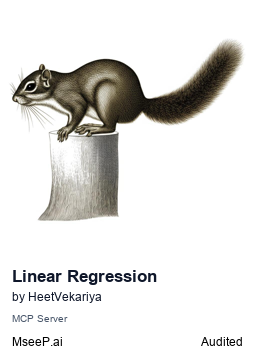About
An end‑to‑end ML workflow server that lets Claude train a linear regression model from a CSV file, handling preprocessing, training, and RMSE evaluation automatically.
Capabilities

Overview
The Linear Regression MCP server offers a fully automated, end‑to‑end machine‑learning pipeline that can be driven entirely by an AI assistant such as Claude. By simply uploading a CSV file, the server handles data ingestion, preprocessing, model training, and evaluation—culminating in a regression model whose performance is quantified by RMSE. This turnkey solution removes the need for developers to write boilerplate code, enabling rapid experimentation and deployment of linear models in production or research settings.
Problem Solved
Developers often struggle with the repetitive, error‑prone steps involved in building a regression model: cleaning data, encoding categorical variables, selecting the target column, and tuning hyperparameters. The MCP server abstracts these details behind a set of intuitive tools, allowing AI assistants to orchestrate the entire workflow with natural language commands. This reduces development time, lowers the barrier for non‑experts, and ensures consistent execution across different datasets.
Core Capabilities
- File Upload & Storage – accepts any CSV and retains it for subsequent operations.
- Schema Discovery – lists column names, while flags non‑numeric features.
- Data Transformation – automatically converts categorical columns into numeric labels, preparing the data for model training.
- Model Training & Evaluation – trains a scikit‑learn linear regression model on the processed data and returns the root mean squared error, providing immediate feedback on predictive quality.
These tools are exposed through MCP’s resource and tool interfaces, making them discoverable by any AI client that understands the protocol.
Real‑World Use Cases
- Rapid Prototyping – Data scientists can quickly prototype linear models on new datasets without writing code, focusing instead on feature engineering and interpretation.
- Educational Platforms – Instructors can demonstrate the full ML pipeline to students, allowing them to experiment with data and observe results in real time.
- Embedded Systems – Small applications that require lightweight regression (e.g., IoT sensor calibration) can delegate the heavy lifting to an AI assistant while keeping the deployment footprint minimal.
- Automated Reporting – Business analysts can upload sales or customer data, trigger a model, and receive RMSE scores to assess forecast accuracy.
Integration with AI Workflows
Because the server adheres to MCP standards, any Claude or other AI client can seamlessly invoke its tools. An assistant might ask the user to “upload my sales data,” then automatically call to confirm the target column, perform encoding, and finally train the model—all through conversational prompts. The AI can also return the RMSE and suggest next steps, such as feature selection or model refinement, creating a continuous loop of improvement without leaving the chat interface.
Unique Advantages
- Zero Coding for End Users – The entire pipeline is accessible via natural language, eliminating the need to touch code.
- Consistent, Reproducible Results – The server’s deterministic preprocessing and training steps ensure that repeated runs on the same data yield identical RMSE values.
- Modular Toolset – Each function is a discrete tool, allowing developers to compose custom workflows or extend the server with additional preprocessing steps.
- MCP‑Ready – Full compatibility with Claude Desktop and other MCP clients guarantees easy integration into existing AI toolchains.
In summary, Linear Regression MCP empowers developers and analysts to harness the power of linear modeling through an AI‑driven, protocol‑compliant interface—streamlining the journey from raw data to actionable insights.
Related Servers
MarkItDown MCP Server
Convert documents to Markdown for LLMs quickly and accurately
Context7 MCP
Real‑time, version‑specific code docs for LLMs
Playwright MCP
Browser automation via structured accessibility trees
BlenderMCP
Claude AI meets Blender for instant 3D creation
Pydantic AI
Build GenAI agents with Pydantic validation and observability
Chrome DevTools MCP
AI-powered Chrome automation and debugging
Weekly Views
Server Health
Information
Explore More Servers
USPTO Patent MCP Server
Fast access to US patents and applications via MCP
Tongchenglvxing MCP Server
Simplify train ticket queries via MCP
DuckDB MCP Server
Local SQL engine for LLM-powered data queries
MCPfinder
App Store for AI tools, instant capability discovery
Layered Code
AI‑Powered Conversational Development Engine
Search Engine with RAG and MCP
Agentic web search powered by RAG, LangChain, and MCP